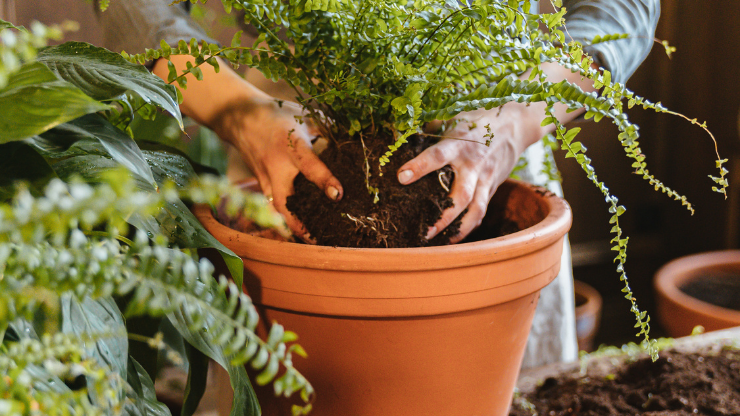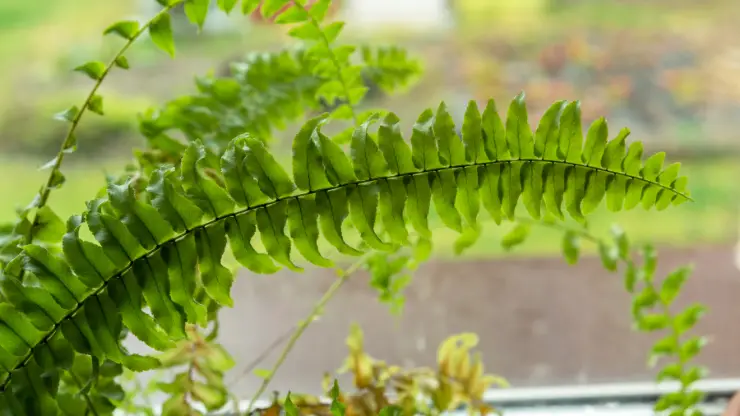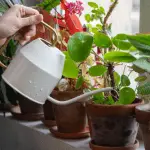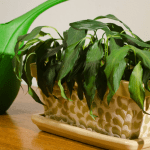
Houseplant lovers everywhere enjoy the soft, tropical touch brought to our homes by indoor ferns. And while they aren’t necessarily hard to grow, most ferns require high levels of moisture and humidity. You may be wondering, “How much should I water my indoor fern?” The answer to that question is probably more than you thought!
In this post, we’ll take an in-depth look at how to properly water your indoor ferns to make them as happy as possible in your home. For some ferns (like maidenhair fern and emerald fern) getting conditions just right be a challenge, but any fern can thrive indoors with the proper care.
Potting for Success
Ferns have shallow, fibrous roots that quickly fill up the soil near the surface of their containers. For the best results, plant your indoor ferns in pots that are as wide as they are deep. This ensures all the roots get adequate water. Deep pots may cause dehydration over time.
Clay pots darken in color when damp, which makes them ideal containers for growing indoor ferns. They serve as moisture indicators, so you know at a glance if the soil is moist or dry. However, clay pots also dry out more quickly than plastic or ceramic.

If you choose clay pots, consider double-potting your indoor ferns to increase moisture and prevent them from drying out too quickly. Here’s what to do:
- Place your fern’s main clay container into a second, slightly larger plastic container that’s been lined with moist sphagnum moss. (You can buy sphagnum moss at your local pet store or plant nursery, or buy it online from Amazon.)
- Keep the moss moist (or even wet) at all times. This will prevent the clay pot from drying out and keep the soil moist for your ferns.
How Much Should I Water My Indoor Fern?
Consistent watering and keeping the soil moist (but not wet) is necessary for the health of your indoor fern. Water lightly and often for the best results. Overwatering may cause root rot and fungal disease, while underwatering leads to impaired growth and wilting.
So, how much should you water your indoor fern? Honestly, it depends on the type of fern. But in general, you want to check your fern daily in the spring and summer (during active growth). If the soil feels dry when you insert your finger up to the first knuckle, water lightly. If the soil still feels moist, check again the next day.
During winter, check your fern twice a week (once every three to four days). Water lightly when the soil feels dry. But keep in mind there are a few exceptions to this rule. Rabbit’s Foot Fern, Brake Ferns, and Holly Fern can tolerate the soil drying out slightly between waterings.

Tips for Watering Your Ferns
Here are some expert tips for watering your ferns and keeping them happy in an indoor environment:
- Keep a small spray bottle filled with room temperature water near your ferns. Use this to mist the foliage each time you check the soil moisture. Make this a habit to keep the humidity high, which is a necessity for most types of indoor ferns.
- When the soil seems dry (after testing as instructed above), dribble a little of the water from the spray bottle into the soil.
- Always use room temperature water when watering or misting ferns.
- Never allow a fern to sit in standing water for more than a few minutes at a time.
Signs of an Overwatered Fern
It’s usually quite easy to tell if you’ve overwatered an indoor fern. Signs include fronds turning yellow and wilting, and roots turning black and rotting. You may also notice the soil is wet or soggy instead of lightly moist (as it should be).
If you think your fern may be suffering from too much water, reduce the amount you’re giving at each watering. Clip off any damaged leaves, and check the roots to make sure they’re not rotting. If the roots are mostly black and mushy, you may have to discard the plant.
See my post on how to fix overwatered plants for more information on this topic. If you have no or minimal root rot, it’s still possible to save your fern. If extensive root rot has developed, it may be too late – but it never hurts to try!

Signs of an Underwatered Fern
Underwatered ferns may also appear wilted with fronds that droop and turn brown. Browning edges can also indicate low humidity or natural aging, so it’s not always caused by too little water. But if the soil feels very dry or is pulling away from the pot, it’s probably underwatered.
If you suspect your fern is suffering from too little water, increase the amount of water you’re giving at each watering, clip off any brown leaves, and follow the instructions below to rehydrate you fern and bring it back to health.
How to Rehydrate a Dried Out Fern
It’s much easier to revive a dried out fern than an overwatered one. Here’s how to rehydrate an underwatered fern and bring it back to life:
- Fill a tub or sink (large enough to fit the entire pot inside) with room temperature water.
- Submerge the pot just to the rim, keeping the fronds out of the water. Hold the pot under the water for about 2 minutes, or until bubbles stop floating to the surface. Remember to remove the outer pot if you have double-potted your fern.
- Remove the pot from the water and drain until it stops dripping water from the drainage holes. I recommend placing it in a clean sink or tub for about 10 to 15 minutes. If it’s still dripping after that, leave it for another 10 to 15 minutes, until it’s no longer dripping.
- Move the fern back to its normal location and resume normal care. It should begin to spring back to life within a few hours.
See my post on how to revive under watered plants for more in-depth information on this process.
Related Questions
Here are some commonly asked questions related to “How much should I water my indoor fern?” that you might find helpful (and my answers to them).
Can You Water Ferns From the Bottom? Yes, although it’s not necessary, you can definitely water ferns from the bottom. This is a good idea if you forget to water for a few days and your fern becomes dry – but not too dry to do a full rehydrate. Only bottom-water ferns once every other watering. They need top-watering too, to flush out mineral build-up from the soil.
How Do You Water Indoor Ferns? Lightly pour water into the top of the soil using a watering can with a narrow spout. Lift up the fronds and water underneath them. Don’t pour water directly onto the fronds if you can help it. And make sure to water as evenly as possible so all roots take up adequate moisture.
How Much Water Does an Indoor Fern Need? It needs enough water to keep the soil consistently moist, but not soggy or wet. For the best results, check soil moisture daily in spring and summer. Water when soil feels dry to the touch. In winter, check a few times a week. Never allow the soil to dry out completely.
Do Indoor Ferns Need a Lot of Water? Yes, they do need a lot of water. Most indoor ferns like consistently moist soil. Watering lightly and often is the best method for keeping your fern happy. Soil should be moist, but never wet. Over-watering leads to root rot, which is a death sentence for houseplants.
How Often Should You Water a Potted Fern? In general, you should water a potted fern once every other day in spring and summer, and twice a week during winter. However, this may vary depending on the conditions in your home and the type of fern.
Don’t let a timetable dictate your watering schedule. Instead, get to know your potted ferns. Check soil moisture daily and water lightly when the soil feels dry. And don’t forget to check out your specific fern’s individual care requirements, as some have different needs than others.




